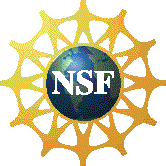Theory Research
 The Theoretical Particle Physics & String Theory group at Virginia Tech
is working on a wide range of problems addressing the fundamental nature of the
universe and its constituents.
The Theoretical Particle Physics & String Theory group at Virginia Tech
is working on a wide range of problems addressing the fundamental nature of the
universe and its constituents.
Our current knowledge of elementary particles and their interactions can be summarized in the chart shown here. There exist 6 flavors of quarks (u, d, s, c, b, t, in the order of discovery) and 6 flavors of leptons (e, μ, νe, νμ, τ, ντ, again in the order of discovery) which interact with each other through the exchange of the force carrier particles. All the quarks couple to γ (photon), g (gluon), Z, and W, while the charged leptons (e, μ, and τ) couple to γ, Z, and W, and the neutrinos (νe. νμ, and ντ) only couple to the Z and the W. |
|
|
Prof. Huber (right) working with a student |
Huber has studied the potential offered by a number of proposed new neutrino experiments to discover a non-zero mixing angle θ13 and to explore leptonic CP violation. The focus of his research was on numerical methods to accurately and efficiently predict physics sensitivities of yet to be built experiments. He works closely with the VT experimental neutrino science group and is himself a member of the Daya Bay Collaboration. Neutrinos are the unique probe of physics not accessible by accelerators like the Large Hadron Collider, and therefore improving our knowledge about neutrinos is highly complementary to traditional collider physics. |
|
Minic has been concentrating his effort on understanding how the quarks and gluons (particles in the upper half of the chart) interact with each other to form baryons, mesons, and glueballs. Baryons are a class of particles that comprise the proton and the neutron which are the basic building blocks of atomic nuclei. Understanding how they are formed from quarks will be a major breakthrough in our understanding of what we are made of. |
Prof. Minic explaining his research to |
|
Prof. Sharpe (left) working with a student |
Sharpe has been interested in understanding what quarks, gluons, and the other particles in the chart above are made of. Together with Minic, he works on various problems in string theory, one current attempt to reconcile particle physics and general relativity. String theory says that each of the particles in the chart above can be understood as a vibration of a one-dimensional object, known as a string. Furthermore, many developments in string theory have had spinoffs which gave more direct insight into particle physics, for example the understanding of strong coupling physics in certain ("supersymmetric") models of quarks and gluons. Although string theory is not directly testable experimentally, there are many indirect tests that can be performed via, for example, the mathematical predictions of string theory, and so he is also interested in mathematical aspects of the subject. |
|
Takeuchi has been interested in figuring out what can be inferred about new physics (particles and interactions that are yet to be discovered) from precision measurements of how the Z and W interact with the quarks and leptons. Most recently, he has been looking at how one flavor of neutrino changes into another (neutrino oscillations) in the presence of matter, and studying what an experimental measurement of the process can potentially tell us about the unknown. |
Prof. Takeuchi (right) discussing a problem over tea with 2008 Nobel Laureate Dr. Yoichiro Nambu (left) at a workshop in Nagoya, Japan, December 2002. |
|
Prof. Minic (right) discussing a condensed matter physics |
In addition to string theory, Minic and Sharpe work together on various fundamental problems quantum gravity and cosmology. Takeuchi also works on electroweak symmetry breaking, CP violation, and the construction of models beyond the Standard Model. The group also works closely together on a variety of different topics such as the foundations of quantum mechanics, and quantum computing. Minic also works with members of the condensed matter physics group on applying string theory techniques to a variety of condensed matter physics problems. |
|
Graduate students working on phenomenology are encouraged to present a talk at the annual PHENO symposium at the University of Wisconsin Madison, in addition to various opportunites available on campus to showcase their research. |
Yee Kao (Ph.D. 2010) presents a talk at Pheno 2009 |
|
Michael Kavic (Ph.D. 2009) defends his thesis. |
During the summer, students are sent to summer schools such as the Theoretical Advanced Studies Institute (TASI) at the University of Colorado, Boulder, the SLAC Summer Institute (SSI) at the Stanford Linear Accelerator Center in California, the Prospects in Theoretical Physics (PiTP) program at the Institute of Advanced Studies in Princeton, New Jersey, the CERN-Fermilab Hadron Collider Physics Summer School which alternates between Geneva, Illinois and Genève, Switzerland, and the Cargèse Summer School on Corcica. |
|
The group is supported by a generous donation from Mr. Mark Sowers, and by research grants from the DOE (DE-FG05-92ER40709, Task A) and the NSF (NSF DMS-0705381, PHY-0755614, DMS-0963840). Research on quantum computing was supported by a grant from the Virginia Tech ASPIRES program during the 2004-2005 academic year. |
Prof. Takeuchi (center) discussing a problem with Prof. Oonogi of Osaka University (right) and 2008 Nobel Laureate Dr. Toshihide Maskawa (left) at a workshop in Nagoya, Japan, December 2009. |








